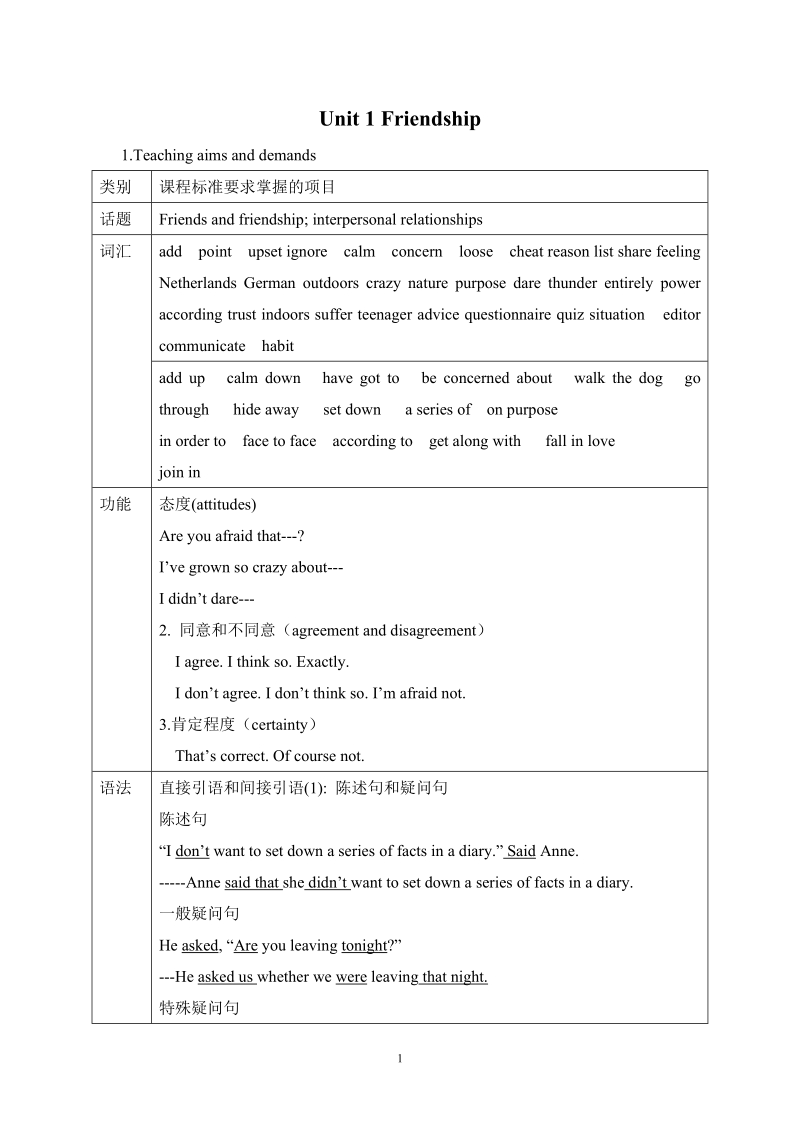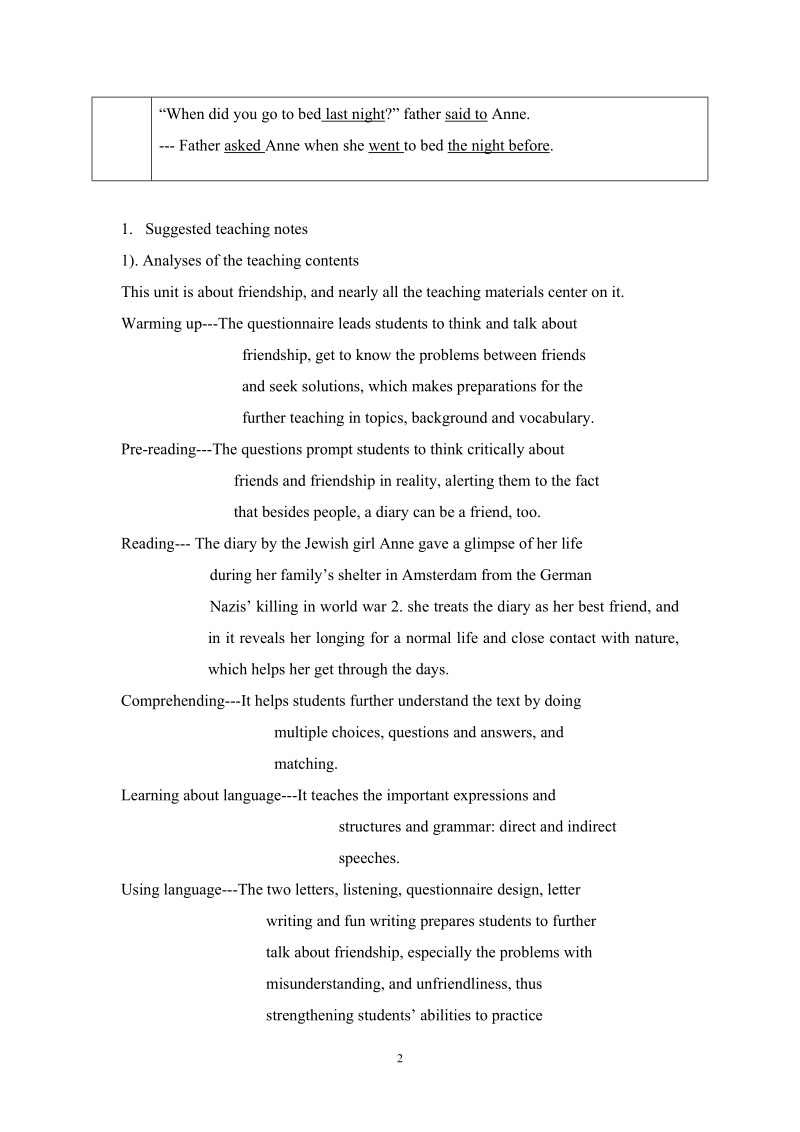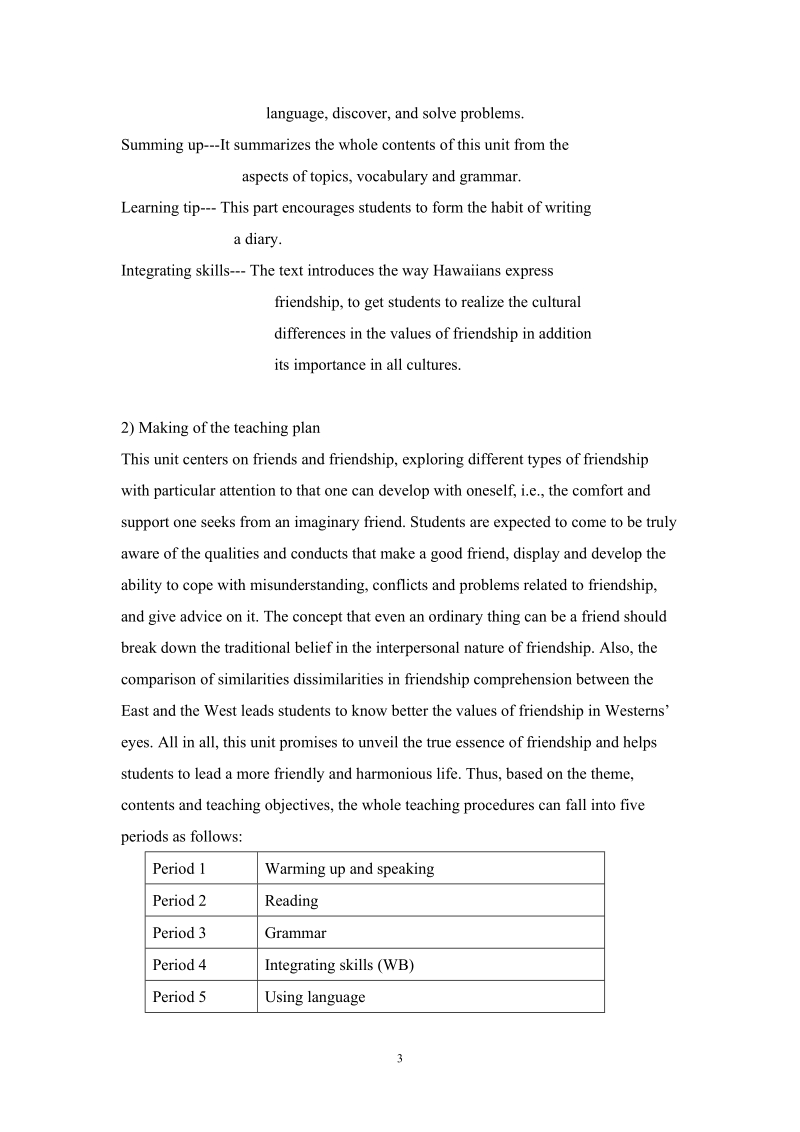 人教新课标高中英语必修1 Unit1教案1
人教新课标高中英语必修1 Unit1教案1
《人教新课标高中英语必修1 Unit1教案1》由会员分享,可在线阅读,更多相关《人教新课标高中英语必修1 Unit1教案1(18页珍藏版)》请在七七文库上搜索。
1、1Unit 1 Friendship 1.Teaching aims and demands类别 课程标准要求掌握的项目话题 Friends and friendship; interpersonal relationshipsadd point upset ignore calm concern loose cheat reason list share feeling Netherlands German outdoors crazy nature purpose dare thunder entirely power according trust indoors suffer teen
2、ager advice questionnaire quiz situation editor communicate habit词汇add up calm down have got to be concerned about walk the dog go through hide away set down a series of on purposein order to face to face according to get along with fall in lovejoin in功能 态度(attitudes)Are you afraid that-?Ive grown s
3、o crazy about-I didnt dare-2. 同意和不同意(agreement and disagreement)I agree. I think so. Exactly.I dont agree. I dont think so. Im afraid not.3.肯定程度(certainty )Thats correct. Of course not.语法 直接引语和间接引语(1): 陈述句和疑问句陈述句“I dont want to set down a series of facts in a diary.” Said Anne.-Anne said that she di
4、dnt want to set down a series of facts in a diary.一般疑问句He asked, “Are you leaving tonight?”-He asked us whether we were leaving that night.特殊疑问句2“When did you go to bed last night?” father said to Anne.- Father asked Anne when she went to bed the night before.1. Suggested teaching notes1). Analyses
5、of the teaching contentsThis unit is about friendship, and nearly all the teaching materials center on it.Warming up-The questionnaire leads students to think and talk about friendship, get to know the problems between friends and seek solutions, which makes preparations for the further teaching in
6、topics, background and vocabulary.Pre-reading-The questions prompt students to think critically about friends and friendship in reality, alerting them to the fact that besides people, a diary can be a friend, too.Reading- The diary by the Jewish girl Anne gave a glimpse of her life during her family
7、s shelter in Amsterdam from the German Nazis killing in world war 2. she treats the diary as her best friend, and in it reveals her longing for a normal life and close contact with nature, which helps her get through the days.Comprehending-It helps students further understand the text by doing multi
8、ple choices, questions and answers, andmatching.Learning about language-It teaches the important expressions and structures and grammar: direct and indirectspeeches.Using language-The two letters, listening, questionnaire design, letter writing and fun writing prepares students to further talk about
9、 friendship, especially the problems withmisunderstanding, and unfriendliness, thus strengthening students abilities to practice 3language, discover, and solve problems.Summing up-It summarizes the whole contents of this unit from the aspects of topics, vocabulary and grammar.Learning tip- This part
10、 encourages students to form the habit of writing a diary.Integrating skills- The text introduces the way Hawaiians express friendship, to get students to realize the cultural differences in the values of friendship in addition its importance in all cultures.2) Making of the teaching planThis unit c
11、enters on friends and friendship, exploring different types of friendship with particular attention to that one can develop with oneself, i.e., the comfort and support one seeks from an imaginary friend. Students are expected to come to be truly aware of the qualities and conducts that make a good f
12、riend, display and develop the ability to cope with misunderstanding, conflicts and problems related to friendship, and give advice on it. The concept that even an ordinary thing can be a friend should break down the traditional belief in the interpersonal nature of friendship. Also, the comparison
13、of similarities dissimilarities in friendship comprehension between the East and the West leads students to know better the values of friendship in Westerns eyes. All in all, this unit promises to unveil the true essence of friendship and helps students to lead a more friendly and harmonious life. T
14、hus, based on the theme, contents and teaching objectives, the whole teaching procedures can fall into five periods as follows:Period 1 Warming up and speakingPeriod 2 ReadingPeriod 3 GrammarPeriod 4 Integrating skills (WB)Period 5 Using language43. Teaching plans for each periodPeriod 1 Warming-up
15、and Speaking1. Teaching objectives:1) Target languageI (dont) think I (dont) think so. I (dont) agree. I believe Thats correct. In my opinion, 2) Ability goalsa. Describe your friends in Englishb. Figure out the problems between friends and then find different ways to solve the problems.3) Learning
16、ability goalsa. To encourage students to think and talk about friends and friendship by using some phrases and structures.b. To learn to solve problems that may occur between friends.c. To cultivate the students to form the good habit of learning English in Senior Middle School.2. Teaching important
17、 points:a. Use the given adjectives and sentence structures to describe one of your friends.b. Learn to evaluate friends and friendship.3. Teaching difficult points:a. Work together with partners and describe one of your good friends.b. Discuss with partners and find out ways to solve the problems.4
18、. Teaching methods a. Task-based teaching and learning5b. Cooperative learningc. Discussion 5. Teaching aids:CAI6. Teaching procedures and ways:Step 1 Lead-in and Warming-upBefore the lesson, the teacher can arouse the students interests by showing a video of Auld Lang Syne .At the beginning of the
19、first class, we can get the students to talk about their summer holidays. The students can talk freely as they like.1. How did you spend your summer holidays? How did you feel? What did you do in your summer holidays? What did you do in your spare time?2. What do you think of our new school? Do you
20、like it? Could you say something about it?3. Do you like making friends? How do get in touch with your friends? Do you have many friends? Where are they now? Do you have any old friends in our school? Have you made any new friends in our class?Step 2 Think it over1. Give a brief description of one o
21、f your friends. The following phrases and structures may be helpful:His/Her name is He /She is years old.He /She likes and dislikes He /She enjoys and hatesHe /She is very kind/friendly/When /Where we got to know each other.62. What types of friendship do you have? Please tick them out. Then fill in
22、 the blanks.girl friends boy friends pen friendslong -distance friends friends of the same agee-friends (friends over the internet) friends across generations unusual friends like animals, books1)._ is /are most important to you. 2). You spend most of your free time with _.3). You will share your se
23、crets with _.4). When in trouble, you will first turn to _.Step 3 Make a survey1. List some qualities of a good friend or your ideal friend. Have the students get into groups of four to find out what each has listed.Tell your partner your standards of good friends by using the following structure: I
24、 think a good friend should (not) beIn my opinion, a good friend is someone who1. Have a member of each group report on what their lists have in common and list them on the board.2. Ask the class whether or not they agree with all the qualities listed.3. Then have the students do the survey in the t



- 配套讲稿:
如PPT文件的首页显示word图标,表示该PPT已包含配套word讲稿。双击word图标可打开word文档。
- 特殊限制:
部分文档作品中含有的国旗、国徽等图片,仅作为作品整体效果示例展示,禁止商用。设计者仅对作品中独创性部分享有著作权。
- 关 键 词:
- 新课 标高 英语 必修 Unit1 教案
 七七文库所有资源均是用户自行上传分享,仅供网友学习交流,未经上传用户书面授权,请勿作他用。
七七文库所有资源均是用户自行上传分享,仅供网友学习交流,未经上传用户书面授权,请勿作他用。
文档标签
- 人教版新课标高中英语必修1全册教案
- 新课标1
- 1必修1
- 人教新课标高中英语必修1 Unit1 Period2教案
- 人教新课标高中英语必修1 Unit1 疑难解析 教案
- 亡羊补牢1
- 人教新课标高中英语必修1 Unit1教案1
- 人教新课标高中英语必修1 Unit1教案4
- 人教新课标高中英语选修六Unit1全单元教案1
- 人教新课标高中英语必修1 Unit1 Period3教案
- 人教新课标高中英语必修1 Unit1 Period1教案
- 人教新课标高中英语选修十Unit1 Reading教案
- 人教新课标高中英语必修1 Unit1 教学设计说明
- 人教新课标高中英语必修1Unit1 Reading课件
- 人教新课标高中英语必修1 Unit1教案2
- 人教新课标高中英语必修1 Unit1教案3
- 人教高中英语必修1
- 高中英语必修1



 浙公网安备33030202001339号
浙公网安备33030202001339号
链接地址:https://www.77wenku.com/p-40105.html